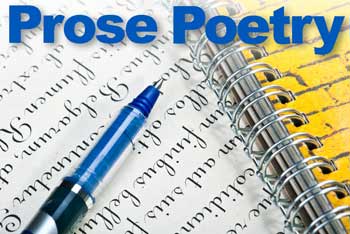An introduction to prose poetry.
Poetry is a vast landscape, populated with many different types of poems from free verse to sonnets to haiku. Prose poetry is unusual because its form deviates from the nature of poetry, which is writing in verse.
Before we examine prose poetry, we first must understand the difference between prose and poetry.
Prose and Verse
Merriam-Webster’s Dictionary defines prose as follows:
a : the ordinary language people use in speaking or writing
b : a literary medium distinguished from poetry especially by its greater irregularity and variety of rhythm and its closer correspondence to the patterns of everyday speech
(adsbygoogle = window.adsbygoogle || []).push({});
Basically, prose is regular text — words formed into sentences that are formed into paragraphs. While prose can be rhythmic and musical, it’s not written in meter or rhyme. The vast majority of writing is prose, from essays and articles to novels and books of nonfiction.
A defining feature of poetry is that it’s written in verse. Merriam-Webster’s Dictionary offers several definitions of verse:
1 : a line of metrical writing
2a : (1) metrical language (2) : metrical writing distinguished from poetry especially by its lower level of intensity (3) : poetry 2b : poem 2c : a body of metrical writing (as of a period or country)
3 : stanza
Verse is metrical and written in stanzas. Like poetry, songs are often written verse, which is why some parts of a song are called verses. Instead of sentences that form paragraphs, which are used to write prose, poetry is composed with metrical lines that form stanzas.
Prose Poetry
At first, prose poetry seems like an oxymoron. If prose is defined by being composed of sentences and paragraphs and poetry is defined as being composed of verse, wouldn’t it be impossible to create something called prose poetry?
As you know, artists are prone to bending and breaking the rules, and poets are no exception. Naturally, they created a form that defied the very rules that define poetry. To understand prose poetry, we need to look beyond structure and examine other elements that define poetry: the creative use of language and imagery, economics of language, and wordplay. Consider this definition of poetry from Merriam-Webster:
writing that formulates a concentrated imaginative awareness of experience in language chosen and arranged to create a specific emotional response through meaning, sound, and rhythm
Although most poetry is written in verse, structure alone does not define poetry. So we can take the other elements of poetry and then reshape the writing into sentences and paragraphs. That’s how you get prose poetry.
According to Wikipedia, “a prose poem appears as prose, reads as poetry, yet lacks line breaks associated with poetry but uses…fragmentation, compression, repetition and rhyme and…poetry symbols, metaphor, and figures of speech. Prose poetry…is essentially a hybrid or fusion of [prose and poetry].”
What is Prose Poetry? Here’s an Example
Take a look at the following excerpt from Campbell McGrath’s aptly titled “The Prose Poem”:
On the map it is precise and rectilinear as a chessboard, though driving past you would hardly notice it, this boundary line or ragged margin, a shallow swale that cups a simple trickle of water, less rill than rivulet, more gully than dell, a tangled ditch grown up throughout with a fearsome assortment of wildflowers and bracken. There is no fence, though here and there a weathered post asserts a former claim, strands of fallen wire taken by the dust. To the left a cornfield carries into the distance, dips and rises to the blue sky, a rolling plain of green and healthy plants aligned in close order, row upon row upon row.
A Little History
Prose poetry can be traced back to the haibun, a Japanese form of prose poetry seen during the 17th century. Western prose poetry emerged in the early 19th century as a rebellion against traditional poetic structures. Poets such as Aloysious Bertrand, Charles Baudelaire, Arthur Rimbaud, and Stéphane Mallarmé used prose poetry as a way to defy the conventions of the day. Throughout the 19th century, poets continued to embrace the form.
Some of the most well-know poets to write in prose including Hans Christian Andersen, Rainer Maria Rilke, Edgar Allan Poe, Walt Whitman, H.P. Lovecraft, and Gertrude Stein.
The new form carried into the 20th century, with American poets writing prose poetry in the 1950s and ’60s, including Allen Ginsberg, Bob Dylan, Jack Kerouac, William S. Burroughs, and Robert Bly, to name a few. And Charles Simic won the Pulitzer Prize for his 1989 collection, The World Doesn’t End, which included prose poems.
However, prose poetry was not embraced by all. T.S. Eliot opposed prose poetry, arguing that it lacked the rhythm and musical patterns of verse.
Writing Prose Poetry
Why write prose poetry? Why would a poet favor sentences and paragraphs over the traditional structure of verses and stanzas?
It depends on the poem and the poet. Your creative vision for a poem might involve a big block of text that is dense rather than the wispier structure of lines and stanzas. Your poem might tell an abstract story that you feel reads better in paragraphs as opposed to verse. Paragraphs result in a different flow than lines and stanzas, and the prose structure might provide the reader with a better feel for the rhythm of your poem.
Do you ever write prose poetry? Have you ever written it? Would you be willing to experiment with it? Share your thoughts by leaving a comment, and keep writing poetry.
Read more: writingforward.com

